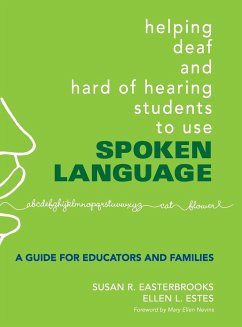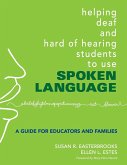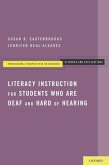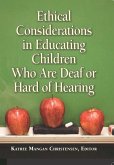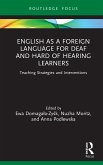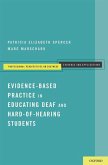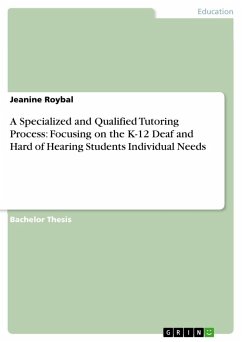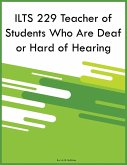Susan R. Easterbrooks, Ellen L. Estes
Helping Deaf and Hard of Hearing Students to Use Spoken Language
A Guide for Educators and Families
Susan R. Easterbrooks, Ellen L. Estes
Helping Deaf and Hard of Hearing Students to Use Spoken Language
A Guide for Educators and Families
- Gebundenes Buch
- Merkliste
- Auf die Merkliste
- Bewerten Bewerten
- Teilen
- Produkt teilen
- Produkterinnerung
- Produkterinnerung
Based on the authors' model of auditory, speech, and language development, the book provides educators with effective techniques and strategies for working with children in the primary grades.
Andere Kunden interessierten sich auch für
![Helping Deaf and Hard of Hearing Students to Use Spoken Language Helping Deaf and Hard of Hearing Students to Use Spoken Language]() Susan R. EasterbrooksHelping Deaf and Hard of Hearing Students to Use Spoken Language46,99 €
Susan R. EasterbrooksHelping Deaf and Hard of Hearing Students to Use Spoken Language46,99 €![Literacy Instruction for Students Who Are Deaf and Hard of Hearing Literacy Instruction for Students Who Are Deaf and Hard of Hearing]() Susan R. EasterbrooksLiteracy Instruction for Students Who Are Deaf and Hard of Hearing62,99 €
Susan R. EasterbrooksLiteracy Instruction for Students Who Are Deaf and Hard of Hearing62,99 €![Ethical Considerations in Educating Children Who Are Deaf or Hard of Hearing Ethical Considerations in Educating Children Who Are Deaf or Hard of Hearing]() Ethical Considerations in Educating Children Who Are Deaf or Hard of Hearing91,99 €
Ethical Considerations in Educating Children Who Are Deaf or Hard of Hearing91,99 €![English as a Foreign Language for Deaf and Hard of Hearing Learners English as a Foreign Language for Deaf and Hard of Hearing Learners]() English as a Foreign Language for Deaf and Hard of Hearing Learners76,99 €
English as a Foreign Language for Deaf and Hard of Hearing Learners76,99 €![Evidence-Based Practice in Educating Deaf and Hard-Of-Hearing Students Evidence-Based Practice in Educating Deaf and Hard-Of-Hearing Students]() Patricia Elizabeth SpencerEvidence-Based Practice in Educating Deaf and Hard-Of-Hearing Students58,99 €
Patricia Elizabeth SpencerEvidence-Based Practice in Educating Deaf and Hard-Of-Hearing Students58,99 €![A Specialized and Qualified Tutoring Process: Focusing on the K-12 Deaf and Hard of Hearing Students Individual Needs A Specialized and Qualified Tutoring Process: Focusing on the K-12 Deaf and Hard of Hearing Students Individual Needs]() Jeanine RoybalA Specialized and Qualified Tutoring Process: Focusing on the K-12 Deaf and Hard of Hearing Students Individual Needs17,95 €
Jeanine RoybalA Specialized and Qualified Tutoring Process: Focusing on the K-12 Deaf and Hard of Hearing Students Individual Needs17,95 €![ILTS 229 Teacher of Students Who Are Deaf or Hard of Hearing ILTS 229 Teacher of Students Who Are Deaf or Hard of Hearing]() Iris Q McKinleyILTS 229 Teacher of Students Who Are Deaf or Hard of Hearing96,99 €
Iris Q McKinleyILTS 229 Teacher of Students Who Are Deaf or Hard of Hearing96,99 €-
-
-
Based on the authors' model of auditory, speech, and language development, the book provides educators with effective techniques and strategies for working with children in the primary grades.
Hinweis: Dieser Artikel kann nur an eine deutsche Lieferadresse ausgeliefert werden.
Hinweis: Dieser Artikel kann nur an eine deutsche Lieferadresse ausgeliefert werden.
Produktdetails
- Produktdetails
- Verlag: Corwin
- Seitenzahl: 226
- Erscheinungstermin: 31. Mai 2007
- Englisch
- Abmessung: 286mm x 221mm x 17mm
- Gewicht: 840g
- ISBN-13: 9781412927321
- ISBN-10: 1412927323
- Artikelnr.: 22390738
- Herstellerkennzeichnung
- Books on Demand GmbH
- In de Tarpen 42
- 22848 Norderstedt
- info@bod.de
- 040 53433511
- Verlag: Corwin
- Seitenzahl: 226
- Erscheinungstermin: 31. Mai 2007
- Englisch
- Abmessung: 286mm x 221mm x 17mm
- Gewicht: 840g
- ISBN-13: 9781412927321
- ISBN-10: 1412927323
- Artikelnr.: 22390738
- Herstellerkennzeichnung
- Books on Demand GmbH
- In de Tarpen 42
- 22848 Norderstedt
- info@bod.de
- 040 53433511
Dr. Susan R. Easterbrooks is a Professor of Deaf Education in the Educational Psychology Department in the College of Education at Georgia State University and has been active in the field of deaf education for over 30 years. Dr. Easterbrooks has been a teacher, clinician, administrator, school psychologist, lecturer, and consultant and has authored numerous articles, chapters, and books on the education of children who are deaf and hard of hearing. She has participated actively on various local, state, and national committees. She currently serves as chair of the committee revising Knowledge and Skills Needed by Teachers of the Deaf and Hard of Hearing for the Division for Communicative Disabilities and Deafness of the Council for Exceptional Children. She participated in the development and revision of guidelines for services to students with hearing loss, published by the National Association of State Directors of Special Education and on the Special Needs committee of the National Board for Professional Teaching Standards. Dr. Easterbrooks resides in Gainesville, Georgia with her husband and son.
Foreword (by Mary Ellen Nevins, EdD) Preface Acknowledgements About the Authors Part 1: The Art of Intervention 1. Listening and Spoken Language Interventions: A Model and Activities for Helping Children Listening Challenges That Children Must Overcome Model of Auditory, Speech, and Language Development Summary 2. Early Detection and Intervention for Infants and Toddlers Early Detection and Intervention Necessary Services for Infants, Toddlers, and Their Families How Listening Develops in Infants and Toddlers How Infants Develop Spoken Language How Toddlers Develop Spoken Language Interventions for Babies Applying the Model With Babies Interventions for Toddlers Applying the Model With Toddlers If a Child Is Not Making Measurable Progress The Need for Flexible Models Summary 3. Intervention for Preschoolers Collaborating With Service Providers What You Need to Know About a Child
s Hearing Loss What You Need to Know About Previous Intervention What You Need to Know About Listening Technology What You Need to Know About a Child With No Prior Services Planning and Implementing Instruction and Interventions Factors to Consider When Planning Lessons Techniques to Use When Conducting a Lesson Interventions for Preschoolers Applying the Model With Preschoolers Summary 4. Interventions for Children in the Primary Grades A Typical Day in the Life of the Young Student With a Hearing Loss The Effects of Hearing Loss in the Classroom Assessing a Child
s Present Levels of Performance The Multidisciplinary Team of Professionals Who Can Assist the Teacher Readiness for School Instructional Considerations Interventions for Children in the Primary Grades Applying the Model With Kindergartners and Early Elementary Children Summary 5. Developing Literacy Skills in Children With Hearing Losses Learning to Read Effective Approaches to Reading Using Reading to Develop Language - A Paradox Assessment Implications for the Special Education Teacher Implications for the General Education Teacher Intervention The Literacy Team Summary Part 2: The Science of Intervention 6. How Children Hear and Talk: Fundamentals of Listening and Speaking The Speech Chain Linguistic Level Physiological Level: The Physiology of Speech Physiological Level: The Physiology of Hearing Acoustic Level Hearing Aids, Cochlear Implants, and Assistive Listening Devices Classroom Acoustics - Increasing the Child
s Ability to Hear and Understand the Teacher and Peers Daily Device Monitoring: Your Responsibility How to Give the Ling Sound Check Summary Resource A: Organizations and Agencies Serving Children With Hearing Losses Resource B: Assessments Resource C: Sound-Object Associations (by Ellen A. Rhoades, EdS) Resource D: Commercially Available Curriculum Guides and Materials References Index
s Hearing Loss What You Need to Know About Previous Intervention What You Need to Know About Listening Technology What You Need to Know About a Child With No Prior Services Planning and Implementing Instruction and Interventions Factors to Consider When Planning Lessons Techniques to Use When Conducting a Lesson Interventions for Preschoolers Applying the Model With Preschoolers Summary 4. Interventions for Children in the Primary Grades A Typical Day in the Life of the Young Student With a Hearing Loss The Effects of Hearing Loss in the Classroom Assessing a Child
s Present Levels of Performance The Multidisciplinary Team of Professionals Who Can Assist the Teacher Readiness for School Instructional Considerations Interventions for Children in the Primary Grades Applying the Model With Kindergartners and Early Elementary Children Summary 5. Developing Literacy Skills in Children With Hearing Losses Learning to Read Effective Approaches to Reading Using Reading to Develop Language - A Paradox Assessment Implications for the Special Education Teacher Implications for the General Education Teacher Intervention The Literacy Team Summary Part 2: The Science of Intervention 6. How Children Hear and Talk: Fundamentals of Listening and Speaking The Speech Chain Linguistic Level Physiological Level: The Physiology of Speech Physiological Level: The Physiology of Hearing Acoustic Level Hearing Aids, Cochlear Implants, and Assistive Listening Devices Classroom Acoustics - Increasing the Child
s Ability to Hear and Understand the Teacher and Peers Daily Device Monitoring: Your Responsibility How to Give the Ling Sound Check Summary Resource A: Organizations and Agencies Serving Children With Hearing Losses Resource B: Assessments Resource C: Sound-Object Associations (by Ellen A. Rhoades, EdS) Resource D: Commercially Available Curriculum Guides and Materials References Index
Foreword (by Mary Ellen Nevins, EdD) Preface Acknowledgements About the Authors Part 1: The Art of Intervention 1. Listening and Spoken Language Interventions: A Model and Activities for Helping Children Listening Challenges That Children Must Overcome Model of Auditory, Speech, and Language Development Summary 2. Early Detection and Intervention for Infants and Toddlers Early Detection and Intervention Necessary Services for Infants, Toddlers, and Their Families How Listening Develops in Infants and Toddlers How Infants Develop Spoken Language How Toddlers Develop Spoken Language Interventions for Babies Applying the Model With Babies Interventions for Toddlers Applying the Model With Toddlers If a Child Is Not Making Measurable Progress The Need for Flexible Models Summary 3. Intervention for Preschoolers Collaborating With Service Providers What You Need to Know About a Child
s Hearing Loss What You Need to Know About Previous Intervention What You Need to Know About Listening Technology What You Need to Know About a Child With No Prior Services Planning and Implementing Instruction and Interventions Factors to Consider When Planning Lessons Techniques to Use When Conducting a Lesson Interventions for Preschoolers Applying the Model With Preschoolers Summary 4. Interventions for Children in the Primary Grades A Typical Day in the Life of the Young Student With a Hearing Loss The Effects of Hearing Loss in the Classroom Assessing a Child
s Present Levels of Performance The Multidisciplinary Team of Professionals Who Can Assist the Teacher Readiness for School Instructional Considerations Interventions for Children in the Primary Grades Applying the Model With Kindergartners and Early Elementary Children Summary 5. Developing Literacy Skills in Children With Hearing Losses Learning to Read Effective Approaches to Reading Using Reading to Develop Language - A Paradox Assessment Implications for the Special Education Teacher Implications for the General Education Teacher Intervention The Literacy Team Summary Part 2: The Science of Intervention 6. How Children Hear and Talk: Fundamentals of Listening and Speaking The Speech Chain Linguistic Level Physiological Level: The Physiology of Speech Physiological Level: The Physiology of Hearing Acoustic Level Hearing Aids, Cochlear Implants, and Assistive Listening Devices Classroom Acoustics - Increasing the Child
s Ability to Hear and Understand the Teacher and Peers Daily Device Monitoring: Your Responsibility How to Give the Ling Sound Check Summary Resource A: Organizations and Agencies Serving Children With Hearing Losses Resource B: Assessments Resource C: Sound-Object Associations (by Ellen A. Rhoades, EdS) Resource D: Commercially Available Curriculum Guides and Materials References Index
s Hearing Loss What You Need to Know About Previous Intervention What You Need to Know About Listening Technology What You Need to Know About a Child With No Prior Services Planning and Implementing Instruction and Interventions Factors to Consider When Planning Lessons Techniques to Use When Conducting a Lesson Interventions for Preschoolers Applying the Model With Preschoolers Summary 4. Interventions for Children in the Primary Grades A Typical Day in the Life of the Young Student With a Hearing Loss The Effects of Hearing Loss in the Classroom Assessing a Child
s Present Levels of Performance The Multidisciplinary Team of Professionals Who Can Assist the Teacher Readiness for School Instructional Considerations Interventions for Children in the Primary Grades Applying the Model With Kindergartners and Early Elementary Children Summary 5. Developing Literacy Skills in Children With Hearing Losses Learning to Read Effective Approaches to Reading Using Reading to Develop Language - A Paradox Assessment Implications for the Special Education Teacher Implications for the General Education Teacher Intervention The Literacy Team Summary Part 2: The Science of Intervention 6. How Children Hear and Talk: Fundamentals of Listening and Speaking The Speech Chain Linguistic Level Physiological Level: The Physiology of Speech Physiological Level: The Physiology of Hearing Acoustic Level Hearing Aids, Cochlear Implants, and Assistive Listening Devices Classroom Acoustics - Increasing the Child
s Ability to Hear and Understand the Teacher and Peers Daily Device Monitoring: Your Responsibility How to Give the Ling Sound Check Summary Resource A: Organizations and Agencies Serving Children With Hearing Losses Resource B: Assessments Resource C: Sound-Object Associations (by Ellen A. Rhoades, EdS) Resource D: Commercially Available Curriculum Guides and Materials References Index

